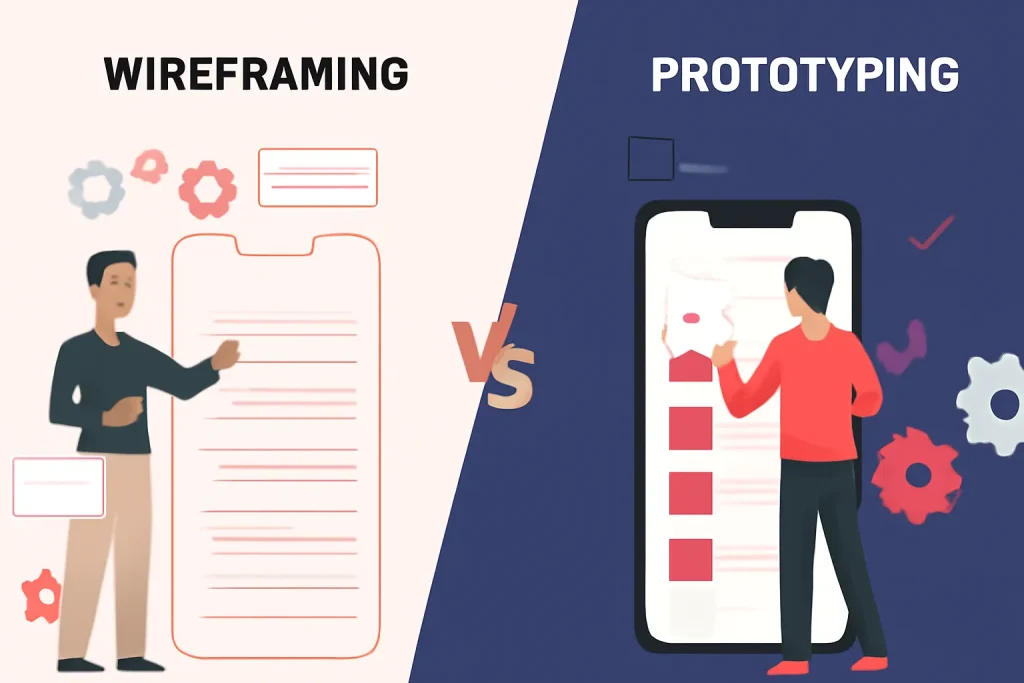What is Wireframing and Prototyping?
In the world of UI/UX design, wireframing and prototyping are essential techniques that ensure the success of digital products. A wireframe serves as a basic, low-fidelity representation of your website or app, helping designers and developers organize the structure, content, and layout. It is the skeletal framework that guides the entire design process, providing a clear outline for the visual hierarchy and content positioning.
Wireframes typically use a grayscale color scheme, consisting of lines and boxes that indicate where key elements will appear on the page. They are devoid of any interactive features or advanced visuals but serve as the backbone of your design, ensuring the basic functionality is set before moving to the next stage.
On the other hand, a prototype is a more advanced, interactive version of your design. It incorporates higher fidelity with colors, animations, and interactive elements. Prototypes allow users to interact with the design as if it were the final product, making them invaluable for user testing. By creating clickable prototypes, you can simulate the user experience, evaluate functionality, and identify potential issues early on in the development process.
Difference between Wireframing and Prototyping

While both wireframing and prototyping are crucial for UI/UX design, they differ in purpose and complexity. Wireframes serve as the foundation of your design, providing a general layout and structure. They focus on content arrangement and layout, providing clarity on how the user will navigate through the interface. However, wireframes are static, meaning they don’t allow for any interaction, making them less representative of the final user experience.
Prototypes, however, offer a higher level of detail and interactivity. They allow designers to showcase more accurate visual design elements and simulate user interactions. This makes prototypes an effective tool for usability testing, allowing you to validate design decisions and gather feedback before proceeding with development.
Types of Wireframing and Prototyping
There are several methods for wireframing and prototyping, each offering varying degrees of detail and interactivity. Here are the three main types:
- Low Fidelity
The simplest method, often hand-drawn on paper. Low-fidelity wireframes are quick to create, cost-effective, and highly collaborative. They provide a basic representation of the layout and structure, without focusing on fine details. This stage is perfect for exploring broad concepts early on in the design process. - Medium Fidelity (Clickable)
Once you’ve completed the hand-drawn version, you can convert it into a clickable prototype. These wireframes include more details than low-fidelity versions and allow for interactive elements, such as buttons or hyperlinks. They give users a closer idea of how the final product will function, although they are still not as refined as high-fidelity prototypes. - High Fidelity (Advanced Interactions & Transitions)
High-fidelity prototypes are the final, most detailed versions of your design. These prototypes closely resemble the final product, featuring realistic interactions, advanced transitions, and high-quality visual elements. They are useful for comprehensive user testing, allowing you to evaluate each element in the user interface before development begins.
If you’re interested in improving your design process, explore our modern UI/UX design services, where we specialize in e-commerce and retail innovations. Our team of experts is ready to help you turn your ideas into successful products with a seamless user experience. Whether you’re building a mobile app or a website, we’ll guide you through each step to ensure the final design meets the highest standards of usability and functionality.
Wireframing and Prototyping Tools
To streamline your wireframing and prototyping processes, various UI/UX design tools can assist in creating efficient and professional designs. Some tools offer both wireframing and prototyping features, while others specialize in one or the other.
Wireframing Tools:
Wirify by Volkside:
A tool that instantly converts any webpage into a wireframe with a single click.
Freehand by InVision:
A digital whiteboard for creating collaborative and shareable wireframes.
Prototyping Tools:
Sketch:
A vector-based design tool ideal for creating high-quality prototypes.
InVision:
A comprehensive platform that integrates with tools like Sketch or Photoshop, allowing you to add animations and transitions to your prototypes.
By using the right tools, you can easily transition from wireframing to prototyping, ensuring a smooth design process that leads to a high-quality final product.
Pros and Cons of Wireframing and Prototyping

Wireframing:
- Pros:
- Clear visualization of layout and structure.
- Efficient communication between teams.
- Focuses on core functionality early in the design process.
- Cost and time-effective.
- Cons:
- Lack of visual details.
- Limited interactivity.
- May overemphasize structure, neglecting aesthetics.
Prototyping:
- Pros:
- Validates design decisions through user feedback.
- Encourages an iterative design process.
- Offers a realistic, interactive version of the product.
- Helps communicate design ideas to stakeholders.
- Cons:
- Time and resource-intensive.
- May lead to misinterpretation of the final product.
- Technical limitations in representing complex interactions.
Conclusion:
Wireframing and prototyping are fundamental steps in the UI/UX design process, ensuring that your digital product is both functional and user-friendly. By combining low-fidelity wireframes with high-fidelity prototypes, you can test and refine your design before development begins. At AssortTech, we integrate these practices with strategic UX consulting to deliver products that not only meet user expectations but exceed them. Contact us to see how we can elevate your design process and bring your ideas to life with seamless, effective solutions.







